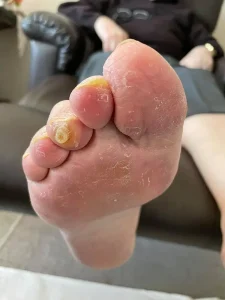 A corn is a protective thickening of skin with a defined hard centre commonly known as a core. A corn can be surrounded by thicker or inflamed skin and commonly form over a bony prominence in the foot or toes due to increased friction or pressure.
A corn is a protective thickening of skin with a defined hard centre commonly known as a core. A corn can be surrounded by thicker or inflamed skin and commonly form over a bony prominence in the foot or toes due to increased friction or pressure.
Firm, dry corns which are commonly seen over the upper surfaces of toes are called hard corns whereas those where the skin is flexible and moist are referred to as soft corns and are usually found between toes.
The skin builds up to protect the bony prominence in the foot but if left too long can become painful.
NOTE: Usually non-malignant in nature, they cause discomfort and can be unsightly in the healthy foot. However, if you have underlying health issues such as poor circulation or diabetes an untreated corn can lead to greater risk of complications such as breakdown of the health tissue beneath the corn or infection.
Causes
Corns form due to a prolonged friction and pressure at a focal point. The core is usually located over the area of greatest friction or pressure.
Common clinical causes are usually:
- Footwear: especially those with a narrow toe box and high heels. This causes an unnatural compression across the forefoot and results in increased pressure.
- Foot and digital deformities: can increase your risk of developing corns such as bunions and hammertoe.
- Footwear material: footwear where the material is unforgiving and firm or if the stitching runs across bony areas could increase the pressure. This could be made worse if the patient chooses not to wear socks.
- Gait: abnormalities or issues resulting in abnormal gait can put increased pressure to one side of the body/foot, eg: LLD
Signs and symptoms
- Thick dead surrounding skin, usually yellow in appearance
- NOTE: long periods of irritation can result in a brown, dark red or black discolouration developing under the corn. This is caused due to the bleeding in the space between the thick skin and the normal healthy skin.
- Hardened raised bump
- Hardened centre/core
- Pain when pressed
- Difficulty walking
- Patients usually compare the feeling to “it feels like I’m walking on a small stone”
Diagnosis and Treatment
Clinical inspection of the foot, toes and between toes is usually enough to diagnose a corn. When directly pressed and pain is elicited is also a common clinical sign.
We encourage you to see a podiatrist if you are experiencing any pain or discomfort around the area of the corn, especially if it is affecting your walking.
Although corns are usually painful in nature this causes delay in seeking help from a podiatrist as they believe removal will be painful too but this isn’t always the case!
A scalpel blade is used to debride the overlying dead skin and then the core is gently enucleated out until soft healthy tissue can be felt at the base.
Your podiatrist will then educate you around how you can try and slow the return of your corn.
NOTE: Please avoid using acid-based treatment like corn pads which, although are easily accessible through the pharmacy, usually cause more harm than good. They tend to irritate the surrounding skin due to acid burn and increase the chance of infection.
This treatment could include:
- Assessing footwear
- Providing cushioning for around or in between toes, eg: gel caps, toe spacers, hikers wool (especially good for soft corns between toes)
If the corn forms over a weight-bearing area orthotics with offloading padding could be prescribed to redistribute pressure away from the corn
In extreme cases where regular podiatry treatment to manage the debridement of the corn, padding and offloading fails, a referral for surgical intervention could be an option. Although not common, surgical intervention could be used to correct any underlying bony abnormalities.